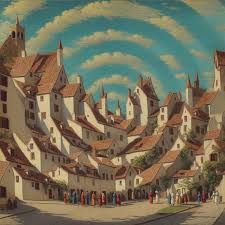Unveiling the Enchantment: Exploring Famous Illusions
The Fascinating World of Famous Illusions
Illusions have captivated and mystified people for centuries, challenging our perceptions and sparking wonder and curiosity. From optical illusions to magic tricks, the world of famous illusions is a realm where reality bends and the impossible seems possible.
The Hering Illusion
The Hering illusion is a classic example of a geometrical-optical illusion that creates the impression of movement in static images. Discovered by the German physiologist Ewald Hering, this illusion plays tricks on our brain’s interpretation of radial lines, making them appear to warp or bend.
The Floating Woman
This famous magic trick has mesmerised audiences for generations. A woman appears to float in mid-air with no visible support, defying gravity and leaving spectators in awe. The secret behind this illusion lies in cleverly hidden mechanisms and skilled performance.
The Ames Room
The Ames Room is a mind-bending optical illusion that distorts perception of depth and size. When viewed from a specific angle, this specially constructed room creates the illusion that people inside it are changing in size as they move around, playing tricks on our sense of perspective.
The Penrose Stairs
Also known as the “impossible staircase,” the Penrose Stairs is an optical illusion that depicts a never-ending staircase where one can continuously ascend or descend without ever reaching a top or bottom. This paradoxical structure challenges our understanding of spatial logic.
These famous illusions are just a glimpse into the vast world of visual trickery and deception that continues to inspire awe and fascination among audiences worldwide. Whether through art, science, or magic, illusions remind us of the boundless creativity and ingenuity of the human mind.
Exploring Perception: 9 Fascinating Optical Illusions That Trick the Mind
- The Müller-Lyer illusion tricks the eye with lines and arrows, making one line appear longer.
- In the Café Wall illusion, parallel lines seem slanted due to staggered black and white tiles.
- The Ames Room creates a distorted perspective, making people appear larger or smaller than they are.
- Rubin’s Vase is an optical illusion where you can see either two faces or a vase depending on focus.
- The Kanizsa Triangle makes you perceive a triangle that isn’t actually drawn by using pac-man shapes.
- In the Ponzo illusion, converging lines make identical objects appear different in size.
- The Ebbinghaus illusion involves circles of different sizes creating a false perception of size comparison.
- Stare at the Lilac Chaser for long enough and you’ll see green dots due to afterimage effects.
- With the Troxler Effect, focusing on one point causes peripheral details to fade away.
The Müller-Lyer illusion tricks the eye with lines and arrows, making one line appear longer.
The Müller-Lyer illusion is a captivating example of how our eyes can be deceived by simple geometric shapes. By strategically placing arrows at the ends of lines, this illusion creates the impression that one line is longer than the other, even though they are actually the same length. This optical trickery challenges our visual perception and highlights the fascinating ways in which our brains interpret spatial information.
In the Café Wall illusion, parallel lines seem slanted due to staggered black and white tiles.
In the Café Wall illusion, parallel lines appear to be slanted despite being perfectly straight. This captivating optical illusion is created by the arrangement of staggered black and white tiles, which trick the brain into perceiving a false sense of tilt. The subtle interplay of contrasting colours and patterns in this famous illusion challenges our visual perception and demonstrates how easily our minds can be deceived by clever design techniques.
The Ames Room creates a distorted perspective, making people appear larger or smaller than they are.
The renowned Ames Room is a captivating illusion that manipulates perception, causing individuals to appear either larger or smaller than their actual size. By cleverly altering the dimensions and angles of the room, this optical trickery plays with our sense of depth and scale, leaving viewers puzzled and intrigued. The deceptive nature of the Ames Room serves as a reminder of how easily our eyes can be deceived, showcasing the fascinating interplay between visual cues and cognitive interpretation in the realm of famous illusions.
Rubin’s Vase is an optical illusion where you can see either two faces or a vase depending on focus.
Rubin’s Vase is a captivating optical illusion that demonstrates the power of perception and interpretation. By shifting one’s focus, viewers can experience a fascinating visual switch between seeing either two faces or a vase in the same image. This intriguing phenomenon highlights how our minds can interpret the same visual stimuli in multiple ways, showcasing the complexity and subjectivity of human perception.
The Kanizsa Triangle makes you perceive a triangle that isn’t actually drawn by using pac-man shapes.
The Kanizsa Triangle is a captivating example of how our brains can create shapes and patterns that aren’t physically present. By strategically placing pac-man-shaped figures in a specific arrangement, the illusion tricks our visual system into perceiving a complete triangle, even though none is actually drawn. This phenomenon demonstrates the power of visual cues and our brain’s ability to fill in missing information to construct meaningful images, showcasing the intriguing interplay between perception and reality in famous illusions.
In the Ponzo illusion, converging lines make identical objects appear different in size.
In the Ponzo illusion, the clever use of converging lines plays tricks on our perception, causing identical objects to appear different in size. This fascinating optical illusion demonstrates how our brain interprets visual cues such as depth and perspective, leading us to perceive the objects as larger or smaller than they actually are. The Ponzo illusion serves as a captivating example of how our minds can be easily deceived by simple yet powerful visual stimuli.
The Ebbinghaus illusion involves circles of different sizes creating a false perception of size comparison.
The Ebbinghaus illusion, a notable example in the realm of famous illusions, showcases circles of varying sizes that deceive the viewer’s perception of size comparison. This intriguing optical phenomenon demonstrates how surrounding context can influence our judgement of an object’s dimensions, leading to a false impression of relative size. By exploring such illusions, we gain insights into the intricate ways in which our brains interpret visual information and highlight the fascinating complexities of human perception.
Stare at the Lilac Chaser for long enough and you’ll see green dots due to afterimage effects.
Staring at the Lilac Chaser illusion for an extended period can lead to a fascinating visual phenomenon where green dots appear due to afterimage effects. This optical illusion plays with our perception, creating an intriguing experience that showcases how our eyes and brain interpret colours and shapes. The subtle yet mesmerising shift in perception serves as a reminder of the intricate ways in which our senses interact with the world around us, highlighting the magic and complexity of visual illusions.
With the Troxler Effect, focusing on one point causes peripheral details to fade away.
The Troxler Effect is a fascinating phenomenon in the world of illusions where concentrating on a single point can lead to the gradual disappearance of peripheral details. This optical illusion demonstrates how our visual perception can be influenced by the brain’s ability to filter out irrelevant information when our attention is fixated on a specific area. By highlighting the dynamic interplay between focus and perception, the Troxler Effect offers a unique insight into how our minds interpret and process visual stimuli, showcasing the intricate complexities of human cognition.


